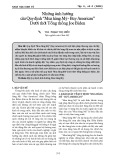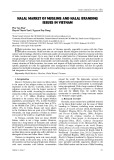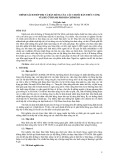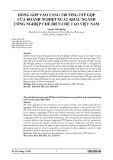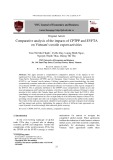
VNU Journal of Economics and Business, Vol. 4, No. 2 (2024) 35-45
35
Original Article
Influence of channel communication on
purchasing sustainable fashion in the Vietnamese market
Dao Cam Thuy*, Do Thi Bich Ngoc, Vu Khanh Linh,
Tran Quynh Anh, Bui Phuong Uyen, Do Hoang Nhat Mai
VNU University of Economics and Business
No. 144 Xuan Thuy Street, Cau Giay District, Hanoi, Vietnam
Received: April 13, 2024
Revised: April 23, 2024; Accepted: April 25, 2024
Abstract: The fashion industry has been widely recognized as a significant contributor to the
ongoing ecological and climate crises, leading to more and more firms realizing the necessity to
promote responsible fashion growth. This study builds upon the research outcomes of earlier
researchers by combining suitable factors relevant to the Vietnamese market and eliminating
inappropriate factors, to investigate the impact of the communication model on choosing and the
consumer’s decision on sustainable fashion products in Vietnam. With 330 survey samples
combined with the SEM regression method, this study shows that 4 factors have an impact on the
attitude of Vietnamese consumers toward sustainable fashion - in order: Receiver Motivation (RM),
Receiver Perception (RP), Communication Message (M), and Channel Suitability (C). Therefore,
Attitude has a direct impact on the Purchase Intention of Vietnamese consumers towards sustainable
fashion products. From these results, the authors have proposed solutions and recommendations to
promote factors affecting consumers’ intention to purchase sustainable fashion in Vietnam.
Keywords: Purchase Intention, communication channel, customer attitude, sustainable fashion.
1. Introduction*
The fashion industry has been perceived as a
primary contributor to ecological and climate
catastrophes. It relies on natural resources,
contaminates at every stage of its supply chain,
and generates substantial waste. Projected to
maintain a consistent annual growth rate of
5.5%, the fashion sector is expected to expand
________
* Corresponding author
E-mail address: thuydc@vnu.edu.vn
https://doi.org/10.57110/vnujeb.v2i6.284
Copyright © 2024 The author(s)
Licensing: This article is published under a CC BY-NC
4.0 license.
further, resulting in significant consequences for
society, the environment, and the sustainability
of economic growth.
Vietnam is seen as a prospective market for
the sector. The value of the fashion market in
Vietnam is estimated to be 5.6 billion USD,
expected to grow annually by 8.8% between
2019 and 2023 (UNEP & UN Climate change,
2023), which has heightened the significance of
VNU Journal of Economics and Business
Journal homepage: https://jeb.ueb.edu.vn

D.C. Thuy et al. / VNU Journal of Economics and Business, Vol. 4, No. 2 (2024) 35-45
36
its impact on the environment. Noteworthy,
Vietnamese fashion consumers are still not well-
informed regarding recycling, reuse, eco-
friendly manufacture, or environmentally
friendly packaging. Consequently, a significant
portion of the outdated and rejected clothing
finds its way into landfills, which poses a
substantial environmental risk to Vietnam.
However, though Vietnam’s sustainable fashion
industry is still in its infancy, this developing
country is gradually recognizing the need to
bridge the gap between mass-produced fashion
accessories and textiles as more and more firms
realize the necessity to promote responsible
fashion growth.
Regarding the impact of sustainable apparel
on consumers’ purchase intention, authors
Rausch & Kopplin (2021) highlighted its
significance in their research. To understand
consumers’ environmental knowledge and
concerns, businesses should gain insights into
their perspectives. The study conducted by Kusá
and Urmínová (2020), which highlighted the
impact of long-term information dissemination
and government pressure on consumer attitudes
towards environmental concerns, reveals that
implementing measures such as recycling
requirements and the gradual elimination of
plastic packaging and products have a
substantial impact on consumer engagement
with environmental concerns. Multiple studies
haveconsistently demonstrated that
communication campaigns aimed at promoting
green fashion influence customer behavior
(Dalen, 2021).
This research aims to investigate the impact
of the communication model on the consumer’s
decision on sustainable fashion products in
Vietnam. Firstly, it aims to determine the
communication elements affecting Vietnamese
consumers’ intention to select sustainable
fashion items and, thus, their shopping decisions.
It aims secondly to collect, examine, quantify,
and evaluate the influence of communication
elements on choice intention to make informed
purchase decisions. Lastly, the study comments
on and makes several suggestions and actions to
support the development of communication
methods in company and brand plans, refining
that approach in light of the data the group
gathered. The results are expected to assist
managers, businesses, and regulators in Vietnam
to prepare or sell sustainable fashion in Vietnam,
hence, improving attitudes and purchase
intentions. Also, the paper seeks to function as a
beneficial reference for forthcoming research
endeavors.
2. Literature review
2.1. Theoretical background
Until the 18th century, scholars and
researchers paid little attention to the concept of
sustainability; one of them (World Ocean
Review, 2015), marked a turning point as he
introduced the notion of “Nachhaltigkeit” or
“sustainable yield” as a means of achieving
perpetual forest management. Sustainability is
assumed to “meet the needs of the present without
compromising the ability of future generations to
meet their own needs.” (Thomsen, 2013).
A similar transformation has unfolded in the
fashion industry. Clothing, once solely serving
the utilitarian purpose of protection, has
powerfully represented self-expression and
social identity (Ray & Nayak, 2023). Our attire
communicates volumes about our backgrounds
and personalities, acting as a silent language
(Cornelia Bohn, 2004). However, the fashion
industry’s traditional practices, characterized by
the fast fashion model’s "take-make-waste"
cycle (UNEP & UN Climate Change, 2023),
have raised serious environmental and social
concerns. With these growing concerns,
sustainable fashion has emerged as a conscious
and responsible approach to fashion. More than
just a passing trend, it promotes eco-friendly
materials, fair labor, waste reduction, and
mindful consumption across the fashion cycle
(Ray & Nayak, 2023).
The fashion industry’s communication
strategies are undergoing a paradigm shift as
well. Previously focused on simply
disseminating information about a brand’s eco-
friendly initiatives, communication has evolved
into a persuasive force known as sustainable
fashion communication. This approach
advocates for a holistic perspective, integrating
sustainability principles into every facet of
consumer interaction within the fashion sector
(UNEP & UN Climate Change, 2023). This vast

D.C. Thuy et al. / VNU Journal of Economics and Business, Vol. 4, No. 2 (2024) 35-45
37
communication ecosystem – designers, brands,
retailers, media outlets, influencers, and social
media platforms – plays a crucial role in shaping
consumer purchase intention toward sustainable
fashion products (Cayaban et al., 2023).
Sustainable fashion communication utilizes
a multifaceted arsenal of tools to influence
consumer behavior. Aspirational content
showcases sustainable fashion in a desirable
light, demonstrating that eco-conscious choices
need not compromise style. Finally, educational
initiatives empower consumers with the
knowledge to make informed decisions that
align with their values (Lin & Chen, 2022). By
disseminating this information through diverse
communication channels, consumers are no
longer passive recipients of marketing messages.
They are transformed into empowered actors,
equipped to make informed choices that reflect
their growing environmental and social
conscience (Arora et al., 2023). Ultimately, this
strategic shift in communication aims to
encourage sustainable consumption patterns,
with the ultimate goal of influencing purchase
intention towards sustainable fashion products.
2.2. Research models
Receiver motivation (customer side)
Customer motivation refers to forces that
encourage people to purchase and consume
commodities. However, it distinguishes itself
from stimuli by denoting individual needs or
wants as sources of motivators for purchasing
activities (Champniss, 2015). It accounts for the
psychic and socio-emotional foundations behind
customer behavior, determining a set pattern of
actions such as buying goods or services
(Champniss, 2015). Maslow’s Hierarchy of
Needs suggests that individuals have a hierarchy
of needs that drives their behavior and
motivations (Mcleod, 2024). Lower-level needs
like physiological and safety needs drive price
and functionality considerations, while higher-
level needs are more responsive to values,
identity, and social impact. Herzberg’s theory
targets hygiene and motivator factors, with
hygiene factors preventing dissatisfaction but
not generating positive feelings (Nickerson,
2023). Motivators drive customer experience
and satisfaction, encouraging active interaction
with a brand.
Receiver Perception (customer side)
Consumer perception describes how
customers and potential customers view a
company and its products and services (Vetrivel
et al., 2023). These media transmit information
about objects and have built-in variations based
on factors such as numerous objects reflecting in
one medium. Customer perception implies that
customers link the information they receive
through their senses to stimuli in their external
environment. Although awareness of
sustainability is increasing, there is still a
problem of consumer knowledge not fully
understanding sustainable fashion to make
informed decisions (Jacobson & Harrison,
2021). Confirmation bias refers to customers
seeking information that supports their initial
beliefs about a brand, leading to trust and loyalty
(Nickerson, 1998). However, trust can be a
barrier for consumers in sustainable fashion, as
it creates skepticism and negative attitudes
(Henninger et al., 2016). For example,
companies like H&M should focus on clear
communication about product origin, production
process, and social impact to build trust and
encourage sustainable fashion purchases.
Different customer risk attitudes and perceptions
can affect consumer shopping behavior.
Communication message (business side)
Messages can encompass a range of
components, including text, pictures, and
feelings, all of which influence how customers
view the company. Karlsson (2015) states that
advertising messages establish a relationship
between senders and receivers, and this
connection enables the process of message
processing. Marketers should provide messages
that arouse feelings in customers and fulfill their
needs. In addition, visual elements in advertising
promote consumer behavior, particularly when
product packaging incorporates signals that
effectively capture the attention of buyers. In a
message, signs, documents, and pictures serve as
symbols in communication, providing
information conspicuously shown (Noble &
Bestley, 2011).
Message framing is a marketing tactic that
manipulates people’s perceptions by presenting
facts. Positive framing focuses on the benefits of
a product or service, while negative framing
emphasizes the losses associated with not using

D.C. Thuy et al. / VNU Journal of Economics and Business, Vol. 4, No. 2 (2024) 35-45
38
the product. Studies have shown that positive
framing arouses more desirable emotions than
negative framing, promoting sustainability
(Chen et al., 2022; Grappi et al., 2024).
However, negative framing is more successful in
getting people to purchase products promoting
recycling (Li et al., 2020). Customers explain
personal ethical decisions and moral judgments
and subjective beliefs combine to shape
consumer behavior (Li et al., 2020).
Additionally, consumers are more likely to have
moral attitudes if they consider them related to
values, identity, and emotions, especially when
evaluated negatively.
Channel Suitability (business side)
Channels are a means of communicating
businesses’ value and message to their intended
audience. Specifically, varying channels provide
varying degrees of customization and
engagement. Following studies by Vladimirova
et al. (2023), social media is an online space for
businesses to market via interaction and
entertainment. In the study by Li et al. (2020),
social media enables information sharing and
consumer engagement, thus promoting brand
loyalty with relevant popular content. When
information is readily available and aligned with
their values, consumers are more likely to think
about and follow through on their purchase
intentions. Fashion brands are employing social
media influencers to reach hard-to-reach
consumers, notably Generation Z (Vladimirova
et al., 2023). Research reveals that influencer
advertisements are more reliable than those from
studios or celebrities. Key Opinion Leaders
(KOLs) or influencers are customers’ main
sources of advice, which affects their habits
because they have more options, and KOLs also
build their brands (Jacobson & Harrison, 2021;
Vladimirova et al., 2023). Lastly, Jacobson and
Harrison (2021) demonstrated that sustainable
blogging may change consumer behaviors by
providing a space for reflection and
communication with content creators and
followers.
Customer attitudes
Understanding consumer attitudes is
fundamental to comprehending purchasing
behavior in a sustainable fashion. In a broad
sense, an attitude can be defined as an
individual’s general view or appraisal of a
certain target (Schleicher and Watt, 2013). These
attitudes are not isolated opinions, but rather a
complex interplay of beliefs, perceptions, and
external influences (Guan, 2022). One key factor
is consumers’ environmental awareness and
participation in sustainable practices.
Individuals actively engaging in sustainability
are more likely to hold positive attitudes toward
sustainable fashion choices (Guan, 2022).
Furthermore, a sense of "perceived behavioral
control" strengthens these attitudes. Consumers
who believe their choices can make a difference
are more likely to adopt sustainable fashion
practices (Guan, 2022). Building trust with
brands and eco-labels is essential for fostering
positive consumer attitudes towards sustainable
fashion products (Abrar et al., 2021). A
significant knowledge gap exists regarding
sustainable practices, and misleading marketing
tactics can create consumer doubt about the true
environmental impact of products (Silva, 2022).
Finally, peer pressure can lead young people to
prioritize trendy styles over sustainable choices,
making it difficult to adopt sustainable fashion
practices (Guan, 2022).
Purchase intention.
Purchase intention is described as a
consumer’s preference to buy a particular
product or service. Simply stated, purchase
intention refers to a consumer’s decision to buy
a product after evaluating it (Younus, Rasheed,,
2015). An advantageous shift in consumer views
and behavior is reflected in purchase intention in
the sustainable fashion sector. This transition is
becoming more significant considering the need
for social and environmental protection. In
simple terms, a customer’s consideration while
purchasing, based on their tastes and
preferences, is known as their buying intention.
Barriers still exist, though, since most
individuals are ignorant about the product
(Wijaya & Paramita, 2021). The study of Abrar
et al. (2021) introduced the concept that
Environmental Apparel knowledge (EAK)
positively impacts perceived behavioral control
(PBC) and purchase intention, in which attitude
mediates the relationship between self-
perception and purchase intention. Numerous
researches have shown a positive correlation
between attitude and purchasing intention. In
line with Paul et al.’s (2016) research, attitude is
a significant mediator between purchase
intention and other variables. People’s intentions
have different aspects or properties that

D.C. Thuy et al. / VNU Journal of Economics and Business, Vol. 4, No. 2 (2024) 35-45
39
influence the prediction of the likelihood of
intention to actual action. The gap between
intention and purchasing behavior is larger
because consumers intend to support
sustainability but do not take actual action
(Rausch & Kopplin, 2021).
2.3. Hypothesis development
The research is built upon previous studies
investigating the discrepancy between positive
attitudes toward sustainable fashion and actual
buying behavior. Despite consumers showing
interest (Zhang & Wang, 2021), there is still a
disconnect (McNeill & Moore, 2015).
Understanding the reasons behind consumers’
decisions to purchase sustainable fashion items
is the focus of important research models. One
of the key theories in this field is the Theory of
Reasoned Action (TRA) put forward by Ajzen
and Fishbein back in 1975. This idea recognizes
that despite having a positive attitude and
societal pressure, a consumer’s ability to follow
through on their intentions may be impeded by
factors such as the availability or affordability of
sustainable options. While the Technology
Acceptance Model (TAM) developed by Davis
(1989) isn’t directly focused on sustainable
fashion, it sheds light on important factors. The
TAM underlines the significance of perceived
benefits, like sustainability, and perceived ease
of use connected to discovering and using
sustainable choices. These aspects indirectly impact
a consumer’s intention to buy sustainable clothing.
H1: Channel suitability positively affects
purchase intention.
H2: Channel suitability positively affects
attitude.
H3: Communication message positively
affects purchase intention.
H4: Communication message positively
affects attitude.
H5: Receiver perception positively affects
purchase intention.
H6: Receiver perception positively affects
attitude.
H7: Receiver motivation positively affects
purchase intention.
H8: Receiver motivation positively affects
attitude.
H9: Attitude positively affects purchase
intention.
Figure 1. Research model proposed
Source: Authors.
3. Methodology
3.1. Measurement instrument
According to Chang &Watchravesringkan
(2018) and Khan et al. (2024), even though
consumers might want to buy sustainable
products, their price can be a barrier. The
research paper by Harjadi & Gunardi (2022)
noted that while there are barriers to sustainable
fashion choices, consumer awareness, and
positive attitudes can influence eco-friendly
purchasing. Moreover, following García-
Santiago (2022), guilt and interpersonal feelings,
alongside positive messages, can promote
sustainable behavior more effectively. Also,
Johnstone (2022) and Kopot & Cude (2021)
argued that social media influencers and
integrated channels are seen as effective ways to
raise awareness and preference for sustainable
fashion. Meanwhile, Hur & Cassidy’s (2019),
Harjadi & Gunardi’s (2022), and Rausch &




